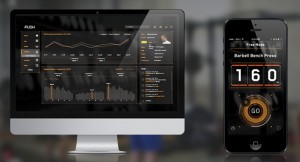 Starting out as a young buck in the Ball State University Biomechanics lab, I was like a kid in a candy store.
Starting out as a young buck in the Ball State University Biomechanics lab, I was like a kid in a candy store.
I was surrounded by some of the best strength and power researchers in the world in Dr. William Kraemer and Dr. Robert Newton.
And I had so many cool gizmos and gadgets, I almost didn’t know what to do with myself!
The coolest gadget was our Kistler force plate. From that one piece of equipment, you could pull a staggering amount of information about the human body and how it performed.
The downside? I think the version we had cost about $30,000!
Today, we’re getting more and more tools to help us customize and dial-in our training, which is why I’ve decided to bring in Matt Kuzdub to tell us about the Push Strength system.
Now before you roll your eyes and think I’m promoting something, I’m not.
I have no affiliation with Push Strength, other than the fact that I’ve bought a Beta version of the system, and I’m beyond excited to start using it with my athletes.
So with all that being said, let’s talk to Matt…
Matt, thanks for taking the time to be with us here today. Could you start by telling us a little bit about yourself?
First off, I am pumped to be here today! Although you’re a Pacers fan, I really enjoy your blog posts, they’re always insightful.
A little about me. I grew up just outside of Toronto playing a ton of sports. At age 13 I decided to focus on one sport, tennis. Most kids in Canada dream about being a hockey player, don’t ask me why I chose tennis.
Apart from that, I’m a huge sports fan. Still waiting for the Leafs to make a big run for the Cup and hoping the Raptors young stars can make an impact this year in the East.
That’s awesome man. How did you get into the sports performance/sports science field?
As I mentioned, tennis has been a big part of my life from an early age. I competed at the national level for years, and while completing my undergrad degree in Kinesiology, I was able to compete at the collegiate level. After my undergraduate degree, I gave the pro tour a shot. For a number of reasons, injury being one of them, my time on tour didn’t last more than a year.
For as long I can remember, I’ve been interested in sports performance but after my brief stint on tour, I was even more interested in what separated top performers from the rest of the pack. I enrolled in a MSc Strength & Conditioning program at the University of Edinburgh in Scotland to study this in more depth.
It was a fantastic experience from an academic and work perspective, as I was fortunate to coach some of the top young junior tennis players in the UK. From there, I moved back to Canada where I trained (and continue to train) elite athletes.
Very cool – you’re quite the world traveler!
Over the years, what have you studied specifically with regards to sports science? What are your main areas of interest? And why?
My master’s research focused on studying the benefits of plyometric training for young athletes. My project confirmed that this style of training can increase performance measures, such as power, speed, and agility.
Plyometrics continue to be an interest of mine, but as an element in a complete strength training program along with Olympic/traditional strength exercises.
As a coach and former-athlete, I am always concerned with the transfer of performance from the gym to the field. This issue of ‘specificity’, is often debated; personally I always look at strength & conditioning as a ‘supplement’ to sport specific training.
If you want to be a better hockey player, don’t neglect your on-ice training. With advancements in technology, I think we’re entering an exciting time where we’re starting to be able to quantifying how actions in the weight room affect what happens on the field.
I agree wholeheartedly here. It’s easy to get caught up in weight room “numbers,” but at the end of the day it’s all about what you do on the court, ice or field that matters.
A few weeks back I was talking with my good friend Joel Jamieson about ways to track velocity and power in training, and he referenced me to the PUSH system. Could you tell us a little bit about it?
 PUSH is an app-enabled wearable device that measures and tracks strength performance at the gym. We are trying to revolutionize the weight training experience by quantifying movement.
PUSH is an app-enabled wearable device that measures and tracks strength performance at the gym. We are trying to revolutionize the weight training experience by quantifying movement.
PUSH utilizes scientifically-validated metrics, such as Peak Force, Peak Velocity and Peak Power to provide a way to track and visualize an athlete’s training performance. This information helps the user optimize their training and allows coaches to detect early signs of fatigue.
We have an app and portal system that connects athletes and coaches for an enhanced social and competitive training experience. Coaches and trainers can also access each  athlete’s personal profile to monitor their progress and prescribe new workouts based on objective results.
athlete’s personal profile to monitor their progress and prescribe new workouts based on objective results.
We are making it easy to visualize trends, extract meaningful feedback on individual performances, and compare progress in relation to a whole team.
That’s very cool. One of the features I love about Joel’s BioForce HRV system is the coaching portal, so I can track trends with all my clients and athletes.
At the risk of sounding sales-y, what differentiates the PUSH system from its competitors?
Historically, most tools that provide similar metrics to what we offer, are large bulky tools that are used in research labs. These tools, like force plates and linear position transducers, are expensive, technical and not very user friendly.
That’s not to say that a force plate isn’t a tremendous tool; it’s the gold standard in the industry and the field has made great progress because of it.
PUSH is offering a similar, scientifically validated metrics, in a very user-friendly package that can be worn during every weight-training session.
During my time at Ball State we obviously had all the cool gadgets, so it’s exciting to see something like this brought to the end user.
Now let’s talk application. Why would someone care to track speed/velocity/power in a gym setting? What’s the benefit(s)?
I know the answer, but I want everyone to know the answer!
Great question. Most major sports (NFL, NHL, NBA) are played at a staggering pace. Athletes are bigger and faster than they’ve ever been, and they are not slowing down.
With that being said, if you’re an athlete seeking to improve speed, then you’re going to have to train fast! So research is starting to target velocity-prescribed training versus traditional load-prescribed training.
I’ll give you an example: if an athlete is performing a hang power clean, knowing the speed (velocity) of the bar during the movement is critical for speed/power development. With PUSH the athlete can set a target for velocity, if the velocity drops below a certain threshold, training should be ceased or the load reduced.
The net effect is training the athlete to perform at high speed. It’s an entirely different way of looking at how to train, in my opinion, a more sophisticated way of training.
In terms of power, strength coaches are always looking for ways to improve an athlete’s ability to be explosive; for cutting movements and tackling in contact sports. The challenge for strength coaches is prescribing a load that will optimize peak power output.
With PUSH, you’ll be able to determine which loads most effectively increase power output for each individual athlete; keeping in mind that each athlete will have a completely different load that maximizes peak power output.
That’s very cool, and again, I’m excited to have this kind of technology available to smaller facilities such as IFAST.
What are some of the issues you’ve run into when developing the system? Or what are things you want to improve upon to make it even better in the future?
From a coach’s perspective, I’m always asking our development team if we can track exercise X and exercise Y. The process of detecting reps and extracting metrics is not a trivial task; each exercise has important features that our algorithms detect.
We’ve sent a couple prototypes to a University in the UK where researchers are conducting validation studies with our device against the gold-standards in sport science, force-plates.
In terms of improving the system, we’re trying not to get ahead of ourselves because we’re committed to creating a robust and validated weight-training product. We’d love to sync the device with heart rate monitors to move to a new level in terms of integrated technologies in sport. We’ve also been talking about developing sport-specific algorithms and starting a focus on rehabilitation.
Last but not least, who would benefit from using this type of technology in their gym, or within their training?
First and foremost, athletes and aspiring athletes. Sports are so competitive these days and if you’re not trying to quantify your training, you’re probably not taking your training seriously.
Apart from that, anyone who goes to the gym and wants to improve their strength and power. I’ve been around gym settings enough to know that bringing a paper and pen to train is a hassle.
We want users to focus on training while still being able to keep track of their workouts. Because PUSH analyzes every rep you take at the gym, we’ll be able to provide trends for volume load, force, velocity and power, without a pad and pen.
Very cool man, and I can’t wait to get our hands on our system.
Matt, thanks a ton for being with us here today. Could you tell everyone where they can learn more about you and the PUSH system?
Absolutely! We launched our pre-order campaign on Oct. 4 and the response so far has been fantastic! We reached our goal within the first 2 weeks and with 3 weeks to go we are making a big push to spread the word.
If people want to learn more, they can visit our website (www.pushstrength.com) or get in contact with me, I’m always eager to hear feedback!
Awesome. Thanks again Matt!
